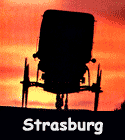Back
| The History of Strasburg Pennsylvania It is often noted that Strasburg, named for the city in France, was actually "founded" by a Frenchman, Pierre Bezaillion, who traded with the Delaware Indians. The story goes he came to the area in 1693, the same year associated with the origin of the Amish faith in Europe. So French fur traders opened up the first path through this area from Philadelphia to the Susquehanna River, known as "Minqua's Path."
 To the east, a group of French Huguenots (Protestants unwelcome in the Catholic country of France) was settling at the same time: families with names like Ferree, LeFevre, and Rhinier, still prominent in Strasburg today. To the east, a group of French Huguenots (Protestants unwelcome in the Catholic country of France) was settling at the same time: families with names like Ferree, LeFevre, and Rhinier, still prominent in Strasburg today.
As early as 1716, when the first wagon was used for hauling goods between Philadelphia and Lancaster County, the Indian path became known as the Conestoga Road. The first wagoner was John Miller. By 1717 there were two more wagons, the first to be described as a Conestoga Wagon. The first buildings appeared in the village about 1733. A traveler, who drove through during the second half of the 18th century, described it as a village of log houses. During the next half century, traffic on this road increased considerably, and Main Street Strasburg was developed. A remarkably intact village today, it boasts a number of buildings constructed before 1815.
The 1769 tax returns list several houses, 53 log, 29 brick, and four stone. About half were 2-story, indicative of the affluence of Strasburg, which in the late 18th century, was second only to Lancaster Borough in terms of relative wealth. Generally the oldest houses were built "on the street," with almost no setback but deep back yards with spacious, productive, flower and vegetable gardens.
Located along the major wagon routes between Philadelphia, Lancaster, and the Susquehanna River. Strasburg was one of the principal stopping stations and, with the heavy wagon traffic, it probably also had many rough travelers. At one time there were as many as eight or ten taverns or "ordinaries" here.
No doubt the religious nature of the first settlers was responsible for the village becoming a center for worship and education. In 1816, when the village was incorporated into a Borough, the name Strasburg was selected, from the Cathedral City from which the "Swissers" came, Strasbourg in Alsace.
In 1791, Bishop Francis Asbury preached in a tavern and reportedly said, "I believe we should have a house of worship and the Lord will have a people in this place." Later that year, Bishop Asbury organized the first Methodist congregation in town. In the early years of its development, the village was blessed with over a half dozen wealthy clergy and physicians. Because of their education and religious background, Strasburg became a cultural and educational center.
Rev. Nathaniel Sample, a Presbyterian minister, was one such individual. In 1790 he founded the "Strasburg Philosophical Society," and in 1791 was also active in the creation of the "Strasburg Scientific Society." As far as is known, Rev. Sample founded Strasburg's first formal school in 1790, a classical academy in which he taught Greek and Latin. Sample also conducted a theological school in the east parlor of his home.
As Strasburg flourished, so did its neighbor to the east, Philadelphia. The commercial interests of Philadelphia pressured the State Legislature to improve the transportation network into their city. As a result, an internal improvements bill was passed in 1826 to construct a series of canals. The Philadelphia and Columbia Rail Road was also incorporated with financing provided by the state.
With these undertakings, Strasburg residents became alarmed at the possibility of losing their commercial position, and from this concern emerged the Strasburg Railroad. In 1832 a charter was secured from the Pennsylvania Legislature to construct a line connecting Strasburg with the Philadelphia and Columbia Rail Road main line near Paradise. Due to financial difficulties, the project was delayed. But finally in the 1850's the train was hauling freight and passengers. About 100 years later, business had dwindled, and a severe storm in 1957 destroyed much of the track. It seemed the railroad had reached the end of the line.
Some local train enthusiasts brought the railroad back to life in a totally new way. Having discovered they could make more money transporting people rather than freight, they soon added more cars and buildings, and today's Strasburg Railroad was born. As America's oldest shortline Railroad, it is now one of the area's top attractions, its trains and cars have been used in many famous movies. From Thomas the Tank Engine events, to the wine and cheese trains, there is much to see and do as you travel the rails on the "Road to Paradise." Appropriately enough, the State decided to build the newly expanded Railroad Museum of Pennsylvania across the street, the ideal place to preserve the history of railroading in Pennsylvania, as well as many historic locomotives and train cars.
Amish County News - September 2010.
Back
|
